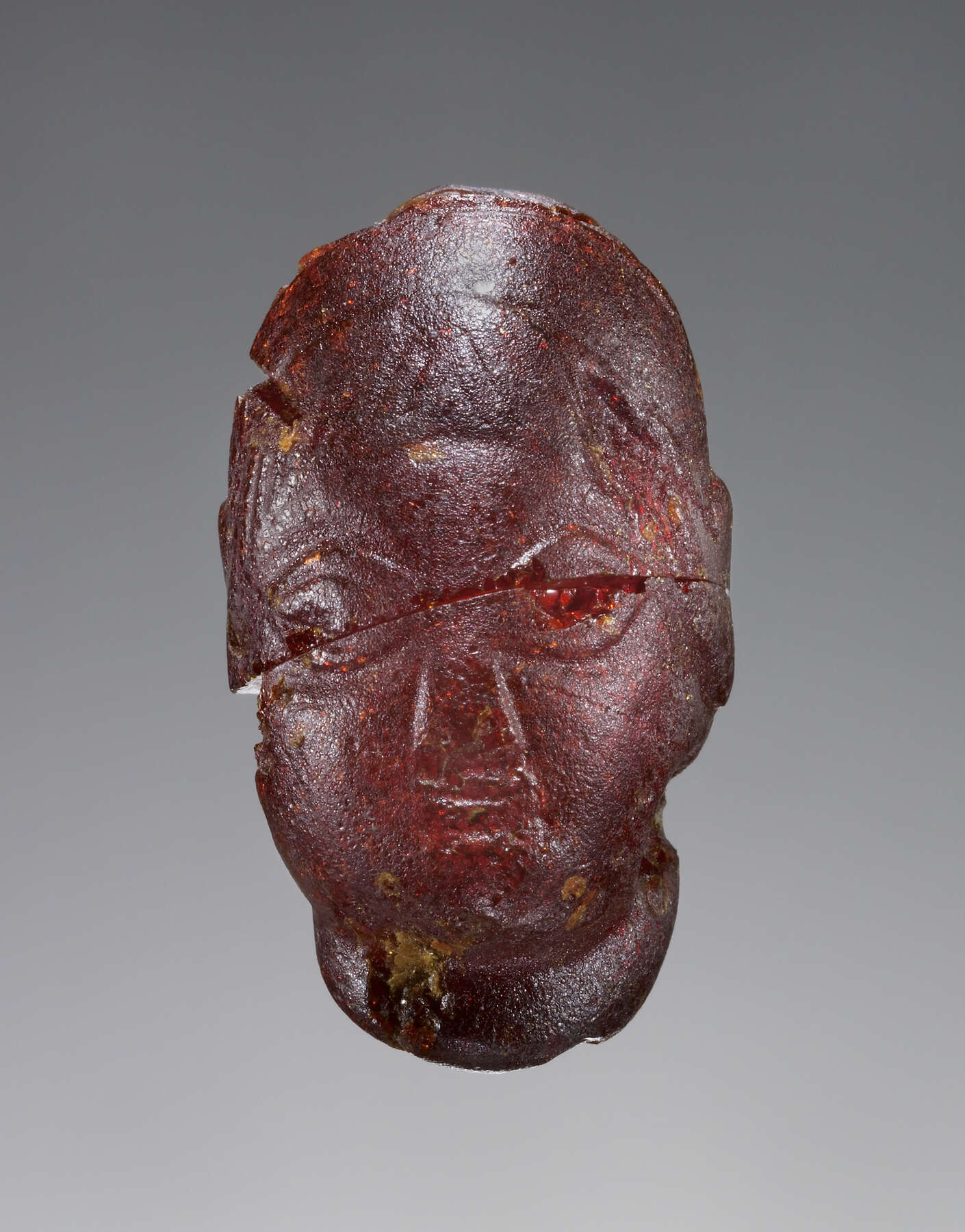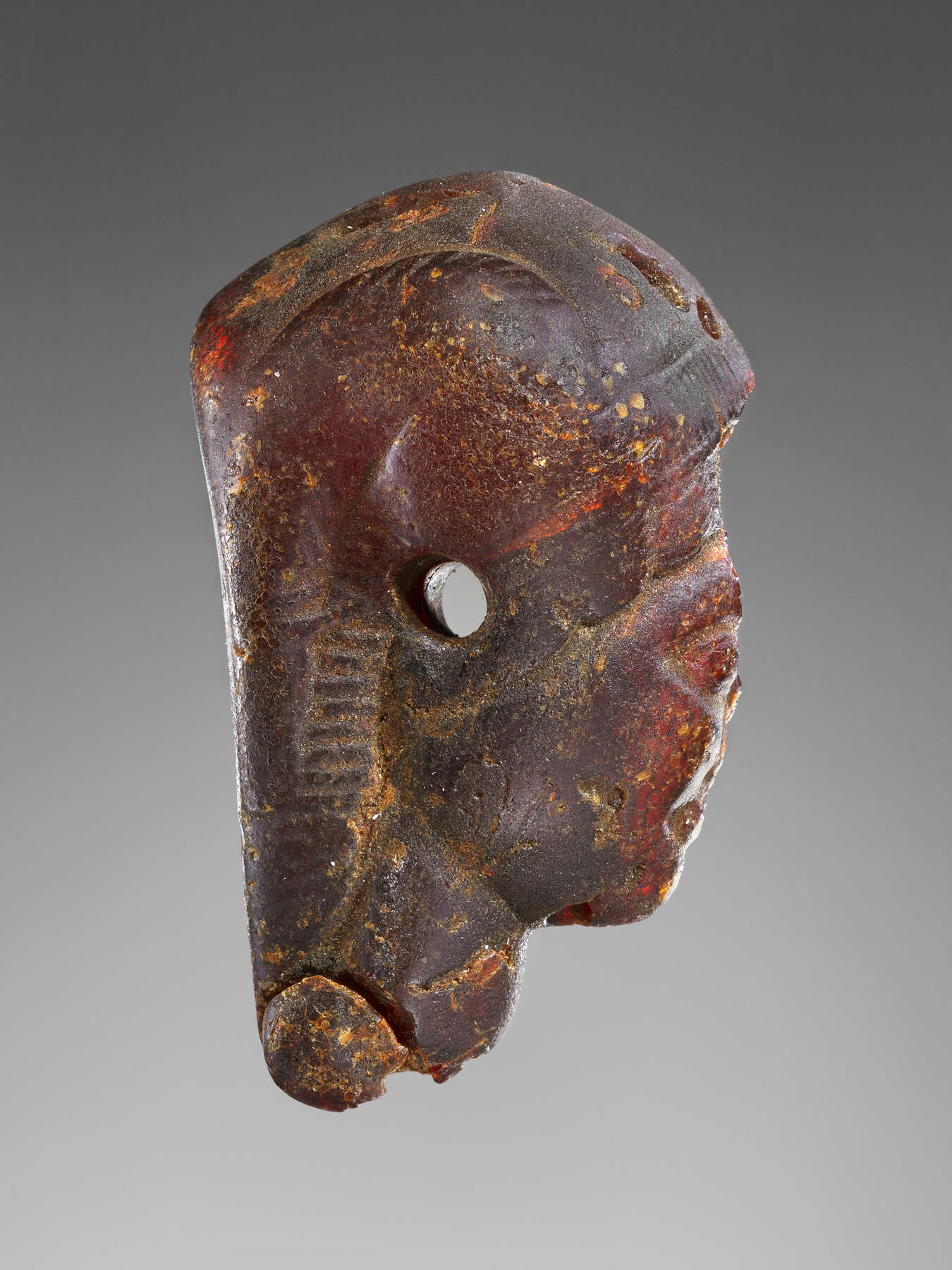23. Pendant: Winged Female Head
| Accession Number | 77.AO.81.5 |
| Culture | Italic |
| Date | 500–480 B.C. |
| Dimensions | Height: 42 mm; width: 23.5 mm; depth: 32 mm; Diameter of suspension hole: 2 mm; Weight: 11.9 g |
| Subjects | Magic |
Provenance
–1977, Gordon McLendon (Dallas, TX), donated to the J. Paul Getty Museum, 1977.
Condition
The surface is stable, firm, and clean, but it is worn, especially on the front of the face. There is a large fracture loss on the reverse at the top; large losses behind the left ear, above the right ear, and at the top front of the head around the cracked suspension hole; and small chips under the right eye and below the jaw. Fissures run downward along the right side of the nose to the chin as well as along the right temple. There are cracks on the face, beneath the chin on the left side, on the temple, and running from the crown to the right ear. There are traces of yellowish degradation residue in the cracks and grooves. The surface is slightly glossy, suggesting an applied consolidant coating. The amber is translucent and dark red-brown in ambient light. Under transmitted light, the pendant is transparent and red. In the large fissure extending from the top, near the eye, to the chin is an inclusion.
Description
77.AO.81.5 represents the head and neck of a female figure. On the back of the head is a wing. The pendant is carved fully in the round. The eyes are large and lozenge-shaped, with the proximal corners nearly joined over the nose. The eyes curve around from the front to the side planes. The lids are indicated by parallel grooves, roughly carved and relatively angular. What remains of the nose suggests that it was a flattish triangular bar. The mouth is small and turned up slightly, as if in a smile. The lips are rendered as curved bars. The nasolabial furrow continues to the jawline, giving the face a jowly look. The ears are small, flat, semicircular nubs. They are located high on the head and overlap the edge of the headdress. The chin is small and the under-chin area fleshy. The neck is set off from the face and from the hair by two deep grooves.
The figure wears a conical hat with a high rounded crown. It is cloth-wrapped. None of her hair is showing in the front. However, at the back of the neck, a section carved with finely spaced engraved lines must represent a long tress. The secondary feathers of the wing on the back of the head are indicated with upward-directional engraved lines.
The shape of the pendant suggests that the original form of the amber was teardrop-shaped. The long smoothed grooves are the result of a precarving cleaning of surface fissures or inclusions. The vestigial neck of the figure is formed from a spur of amber. A 2 mm perforation for suspension passes laterally through the top of the headdress. When suspended, the chin was recessed close to the wearer’s neck, making the eyes look downward.
Discussion
The smoothing on the prominent surfaces—nose, eyes, mouth, and chin—is evidence of considerable preburial use wear. For the figure’s dress, see the entry for (cat. no. 26); for a discussion of wings on amber head-pendants, see the entry for (cat. no. 15). In frontal view, this head has an uncanny similarity to a unique and odd Etruscan votive bronze of a togate male figure in Naples, who wears a close-fitting hat or net incised with a scale pattern. (Or is this the hair?) Hans Jucker places this togate figure in his Populonia group; Emeline Richardson places it in her Late Archaic grouping, Type 2A, Ionians.1 Although there is no close parallel for 77.AO.81.5, it corresponds in dress and type to three other amber head-pendants. One was found with thirteen other head-pendants in a “princely” tomb at Roscigno–Monte Pruno, the context dated to the early fifth century B.C.2 The second is a head-pendant from Tomb 106 at Banzi, from a context dated to the first quarter of the fifth century.3 The third is a much-worn head-pendant in the Getty, . The schematic carving of the eyes, nose, and mouth of 77.AO.81.5 is comparable to that of one of the heads from Tomb 428 at Banzi.4
Notes
- Naples, Museo Archeologico Nazionale 5534, found on Elba: H. Jucker, “Etruskische Bronzen,” (1967): 620–21, figs. 5–6; H. Jucker, “Etruscan Bronzes from Populonia,” in Art and Technology: A Symposium on Classical Bronzes, ed. S. Doeringer, D. G. Mitten, and A. Steinberg (Cambridge, MA, 1970), pp. 199–203, figs. 8a–f; and , p. 232, figs. 522–24. ↩
- For a recent discussion of the find, see , p. 206, n. 20. ↩
- See , p. 59, no. 4, fig. 2.4. ↩
- For an illustration of the head-pendant from Tomb 428 at Banzi, see , p. 125; for discussion of the ambers from the tomb, see . ↩
Bibliography
- Bottini 1987
- Bottini, A. “Ambre a protome umana dal Melfese.” 41 (1987): 1–16.
- Bottini 1990
- Bottini, A. “Le ambre intagliate a figura umana del Museo Archeologico Nazionale di Melfi.” Archeologia: Wrocław Zakład Narodowy im. Ossoli’nskich 41 (1990): 57–66.
- Losi et al. 1993
- Losi, M., B. Raposso, and G. Ruggiero. “The Production of Amber Female Heads in Pre-Roman Italy.” In Amber in Archaeology: Proceedings of the Second International Conference on Amber in Archaeology, Liblice, 1990, edited by C. W. Beck and J. Bouzek, pp. 203–11. Prague, 1993.
- Magie d’ambra 2005
- Magie d’ambra: Amuleti e gioielli della Basilicata antica. Exh. cat. Potenza, 2005.
- Richardson 1983
- Richardson, E. H. Etruscan Votive Bronzes: Geometric, Orientalizing, Archaic. 2 vols. Mainz am Rhein, 1983.


